SOLVING WORD PROBLEMS USING PYTHAGOREAN THEOREM
Subscribe to our ▶️ YouTube channel 🔴 for the latest videos, updates, and tips.
Problem 1 :
A land surveyor uses this diagram to find x, find the length of lake.
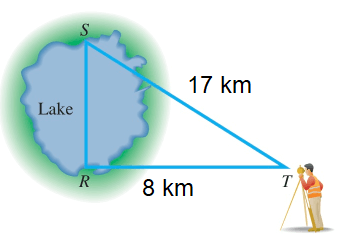
Solution :
Using Pythagorean theorem,
ST2 = SR2 + RT2
172 = SR2 + 82
289 = SR2 + 64
289 - 64 = SR2
SR2 = 225
SR = √225
SR = 15
Problem 2 :
A foot ladder leans against a shed reaching a height of x feet. The base of the ladder is 10 feet from the shed.
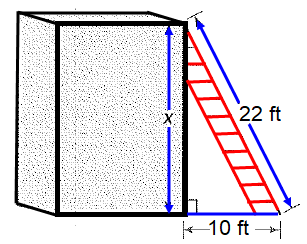
Solution :
Using Pythagorean theorem,
222 = x2 + 102
484 = x2 + 100
x2 = 484 - 100
x2 = 384
x = √384
x = 19.59 ft
Problem 3 :
The diagram shows a sailboat. What is approximate area of the sail shown ?
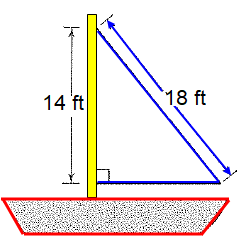
(a) 79 square feet (b) 126 square feet
(c) 158 square feet (d) 200 square feet
Solution :
We use Pythagorean theorem to find the missing side. Let the missing side be x.
182 = x2 + 142
324 = x2 + 196
x2 = 324 - 196
x2 = 128
x = √128
x = 11.31
Area of the boat = (1/2) x base x height
= (1/2) x 11.31 x 14
= 7 x 11.31
= 79.17 square feet
So, the required area is 79 square feet.
Problem 4 :
The television screen has a 25 inch diagonal and a 15 inch height. What is the area of the screen ?
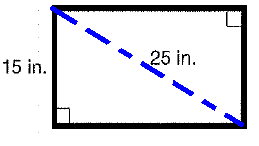
(a) 150 square inches (b) 300 square inches
(c) 375 square inches (d) 437 square inches
Solution :
Let x be the length of the screen.
x2 + 152 = 252
x2 + 225 = 625
x2 = 625 - 225
x2 = 400
x = 20
Area of the screen = length (width)
= 20 (15)
= 300 square inches
Problem 5 :
If two forces, A and B pull at right angles from each other, the resultant force can be represented as the diagonal of a rectangle.
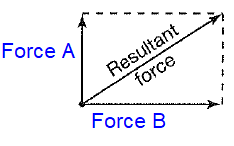
If a 21 pound force and a 28 pound force are pulling of an object, and the resultant force is 35 pounds, are the forces pulling a right angles ?
Solution :
212 + 282 = 352
441 + 784 = 1225
1225 = 1225
Yes the forces are pulling at right angle.
Problem 6 :
The distance across a pond cannot be directly measured. A land surveyor takes some other measurements and uses them to find d, the distance across the pond.
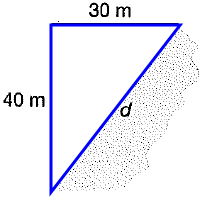
What is the distance across the pond ?
(a) 70 meters (b) 35 meters (c) 50 meters (d) 10 meters
Solution :
302 + 402 = d2
900 + 1600 = d2
d2 = 2500
d = √2500
d = 50
Problem 7 :
The solid line below show the route Maddy's bus takes to school. The dashed line shows a shortcut she takes through the park when she rides her bike to school. What is the difference in km between the shortcut and the usual route ?
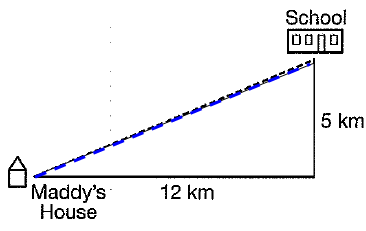
(a) 10 km (b) 4 km (c) 7 km (d) 3 km
Solution :
Let x be the length of the dashed line (short cut)
122 + 52 = x2
144 + 25 = x2
x2 = 169
x = √169
x = 13
Usual distance = 12 + 5 ==> 17 km
Difference = 17 - 13
= 4 km
Problem 8 :
On the map below, the post office is at origin (0, 0) and each unit represents 1 km. Amy lives 6 km east and 8 km north of the post office. if she rides her bike directly from her house to the post office, how far will she ride her bike ?
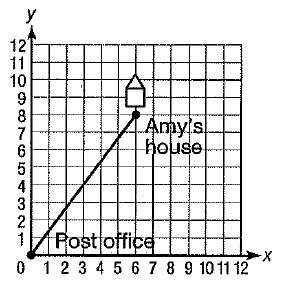
(a) 4.8 km (b) 12 km (c) 10 km (d) 14 km
Solution :
Horizontal distance = 6 km
Vertical distance = 8 km
Distance between Post office to Amy's house = √82 + 62
= √64 + 36
= √100
= 10
She will ride for 10 km.
Subscribe to our ▶️ YouTube channel 🔴 for the latest videos, updates, and tips.
Recent Articles
-
Finding Range of Values Inequality Problems
May 21, 24 08:51 PM
Finding Range of Values Inequality Problems -
Solving Two Step Inequality Word Problems
May 21, 24 08:51 AM
Solving Two Step Inequality Word Problems -
Exponential Function Context and Data Modeling
May 20, 24 10:45 PM
Exponential Function Context and Data Modeling